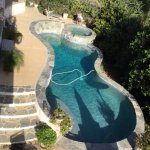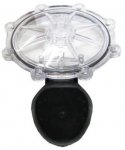Hello all, new member here in San Diego looking for some advice and suggestions in tracking down why our filter pump is losing prime.
Pool was built in 2004 and has been a lot of fun for the family over the years. The equipment's been solid and reliable and it's required nothing beyond the usual maintenance. But now that it's almost a dozen years old, we've started to get a loss of prime issue.
Our house is on a hillside and the pool sits behind the house on the downslope. The equipment is located on the side of the house, about 6-8 feet higher than the water level of the pool.
The filter pump began losing a small amount of prime about year ago, but it was always able to prime itself after less than a minute after starting up. I kept an eye on it and figured I'd get to it after summer. Well the time has come. A couple of weeks ago, I found the pump basket drained and the pump will no longer prime itself.
And I have a devil of time getting it primed. I have to pour a couple of gallons of water into the pump, start it, pour a couple gallons more more, start it, gallons more, etc. Once it starts up, a ton of air bubbles come out of the pool. Once primed it works fine. Pressure is ~ 15-18psi.
It loses prime regardless of whether suction is set to "Pool" or "Spa".
I've tested all unions with soapy water and can't see any leaks. I replaced all the filter o-rings, replaced the pump lid o-ring and replaced the o-rings in all the Jandy valves.
The filter pump is a bit noisy, but not unusually so. Once everything is up and running, there are bubbles under the pump lid. Also, it sounds like air is rattling through the pipes.. I can't pinpoint where exactly.. somewhere on the return side of the filter around the heater. This must mean air is entering on the suction side, correct? Bad pump housing or pump shaft seal maybe?
We have in-ground check valves going to the skimmer, spa and the water feature. These are the only things I haven't really tested or checked - because I don't know how. Is there a way to test these? Or should I just pull them, clean them and replace any rings that look suspicious?
Thanks in advance all!

Pool was built in 2004 and has been a lot of fun for the family over the years. The equipment's been solid and reliable and it's required nothing beyond the usual maintenance. But now that it's almost a dozen years old, we've started to get a loss of prime issue.
Our house is on a hillside and the pool sits behind the house on the downslope. The equipment is located on the side of the house, about 6-8 feet higher than the water level of the pool.
The filter pump began losing a small amount of prime about year ago, but it was always able to prime itself after less than a minute after starting up. I kept an eye on it and figured I'd get to it after summer. Well the time has come. A couple of weeks ago, I found the pump basket drained and the pump will no longer prime itself.
And I have a devil of time getting it primed. I have to pour a couple of gallons of water into the pump, start it, pour a couple gallons more more, start it, gallons more, etc. Once it starts up, a ton of air bubbles come out of the pool. Once primed it works fine. Pressure is ~ 15-18psi.
It loses prime regardless of whether suction is set to "Pool" or "Spa".
I've tested all unions with soapy water and can't see any leaks. I replaced all the filter o-rings, replaced the pump lid o-ring and replaced the o-rings in all the Jandy valves.
The filter pump is a bit noisy, but not unusually so. Once everything is up and running, there are bubbles under the pump lid. Also, it sounds like air is rattling through the pipes.. I can't pinpoint where exactly.. somewhere on the return side of the filter around the heater. This must mean air is entering on the suction side, correct? Bad pump housing or pump shaft seal maybe?
We have in-ground check valves going to the skimmer, spa and the water feature. These are the only things I haven't really tested or checked - because I don't know how. Is there a way to test these? Or should I just pull them, clean them and replace any rings that look suspicious?
Thanks in advance all!




